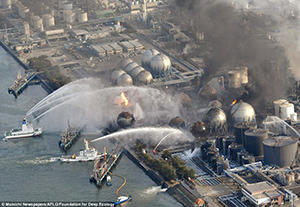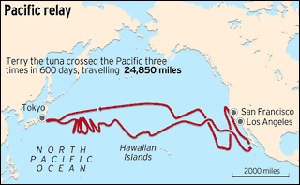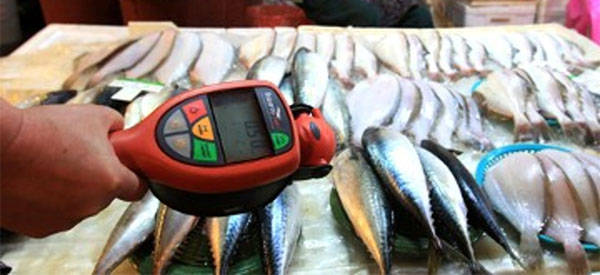On March 11th, 2011, the Fukushima Daiichi Nuclear power plant was hit by natural forces that were beyond its capability to withstand. It all started with the Tōhoku earthquake, approximately 70 kilometers east of the Oshinka Peninsula. This was the most powerful earthquake in the history of Japan and the fourth most powerful on record, measuring 9.1 on the Richter scale.
This earthquake was so powerful that it moved the Japanese island of Honshu 2.4 meters to the East, shifted the Earth’s axis between 10 and 25 cm, increased the earth’s rotational speed slightly and created a tsunami with waves as tall as 40.5 meter (133 feet) that struck eastern Japan.
 Looking at it dispassionately, it’s not surprising that the earthquake damaged the nuclear power plant. But that would have been a survivable accident, were it not for the other effects of the earthquake and resulting tsunami. Recognizing the danger, systems in the active reactors immediately shut down form the earthquake, a pre-programmed response to protect the people of Japan. But nuclear reactors generate an enormous amount of heat, and the tsunami disabled the generators which should have provided power to the pumps necessary to cool the reactors.
Looking at it dispassionately, it’s not surprising that the earthquake damaged the nuclear power plant. But that would have been a survivable accident, were it not for the other effects of the earthquake and resulting tsunami. Recognizing the danger, systems in the active reactors immediately shut down form the earthquake, a pre-programmed response to protect the people of Japan. But nuclear reactors generate an enormous amount of heat, and the tsunami disabled the generators which should have provided power to the pumps necessary to cool the reactors.
Without those pumps in operation, three of the reactors melted down, there were hydrogen-air explosions and radioactive material in three of the reactors was released into the environment. Contamination is continuing, seven years later, as groundwater seeps into the damaged reactors and mixes with the radioactive material.
It was the loss of cooling, more than anything else which led to the massive damage caused by the nuclear power plant’s destruction. The meltdown of the reactors themselves, which included the meltdown of the nuclear materials, allowed those refined nuclear materials to sink into the ground, below the containment built to house the reactor. Today, scientists are unsure exactly how far below ground the radioactive material is, but are estimating that it is between the reactor and the underground aquifers that the Japanese people depend on.
This accident has been rated as a level 7 nuclear event on the INES (international nuclear and radiological event scale), the highest rating that can be applied. Only one other nuclear accident has been considered to be severe enough to receive this rating, Chernobyl.
Related: Where to Go When You Don’t Have a Nuclear Bunker
Contamination From The Accident
The Fukushima Daiichi Nuclear Power Plant is located on the eastern coast of Japan, guaranteeing that an accident of this severity would affect the Pacific Ocean. This contamination started almost immediately, with the operators of the power plant releasing overheated coolant water into the ocean in an effort to prevent a more serious accident. In addition, radioactive gas was released from the pressure vessels, in an effort to reduce the chances of explosion.
About 19 pounds of caesium-137 entered the ocean in the following months. However, this was not the only radioactivity to reach the ocean water. Even today, rainwater flowing over the contaminated ground is washing more radiation into the sea, as well as the ongoing contamination of groundwater beneath the site. How much that interacts with the ocean water is not clear at this time.
The ocean currents off the coast of Fukushima are some of the strongest in the world, spreading this contamination far into the Pacific Ocean. It is hard to judge just exactly how far this has spread, as there has been a constant stream of fear-mongering propagated by environmental groups. While it is clear that the radiation has spread, and even spread far enough to reach the western coast of the United States, the levels of contamination are very low.
Monitoring by the Preparatory Commission for the Comprehensive Nuclear Test Ban Treaty Organization (CTBTO), an anti-nuclear power agency, has picked up radioactive isotopes at over 40 monitoring stations, including in the southern hemisphere. However, even though caesium isotopic concentrations off the coat of Japan being 10 to 1000 times above the norm, radiation levels are still below the level that is considered dangerous to marine life and human consumers.
It is important to note, that to date, there have been no deaths or illness attributed to radiation from the Fukushima Daiichi Nuclear Power Plant, other than those which were attributed to the original accident, which were mostly caused by the tsunami, not the power plant accident.
Related: The Best Way to Prepare Your Home for A Nuclear Attack
What This Means For Our Tuna
 Tuna is one of the more prolific fish worldwide, growing and being harvested in both the Atlantic and Pacific oceans, with more coming out of the Pacific Ocean. Many Pacific Tuna are born off the eastern coast of Japan, where they are guaranteed to spend at least part of their lives swimming through water with at least some radioactive contamination. These fish are highly migratory and will swim thousands of miles in their lives.
Tuna is one of the more prolific fish worldwide, growing and being harvested in both the Atlantic and Pacific oceans, with more coming out of the Pacific Ocean. Many Pacific Tuna are born off the eastern coast of Japan, where they are guaranteed to spend at least part of their lives swimming through water with at least some radioactive contamination. These fish are highly migratory and will swim thousands of miles in their lives.
If you believe the fear mongers, the radiation levels in the Pacific Ocean are so high, that one would expect the fish to be glowing. But they are not. As with much fear mongering, the scope of the problem is being magnified exponentially. Any radiation at all is being reported as major concentrations, confusing the issue for the sake of politics.
Albacore Tuna caught off the shores of Washington and Oregon were found to have some contamination suspected of coming from the Fukushima accident. But you would have to eat 700,000 pounds of the fish they examined with the highest radiation level, to match the amount of radiation the average person is exposed to annually from our environment.
In other words, while any tuna you eat today is likely to have swum in waters which have been contaminated by the Fukushima accident, it really doesn’t matter. The levels of contamination are so low, regardless of what some people are saying, that the fish you eat won’t contain enough radiation to affect your health at all. In fact, you’d get more radiation out of eating a nice fresh banana, than you will from eating the canned tuna sitting on your supermarket shelf.
So don’t worry about stockpiling tuna. It’s not going to make you start glowing and you’re not going to start having two-headed kids. Or if you do, at least it won’t be the tuna’s fault.
You may also like:
 7 Super Cheap Foods To Stockpile That People Usually Throw Away
7 Super Cheap Foods To Stockpile That People Usually Throw Away
The Best Natural Remedies You Can Make With Vegetables From Your Pantry (Video)
My First Batch Of Canned Cheese
10 Long Shelf-Life Canned Foods Every Prepper Should Consider Stockpiling












Well I’m not a tuna fan but I looove salmon and I am in Alaska right now trying to catch some. I would assume salmon are not contaminated much as well. And if they are that’s just too bad because I’m going to eat them anyway. Can’t live by fear.
Good luck with your salmon fishing.
I am with Wannabe. What passes for news these days is designed to just sell and not inform. It is interesting watching the newscasters on NHK as compared with U.S. newscasters. NHK newscasters calmly announce the news without a lot of hyperbole. U.S. newscasters seem to be on the constant edge of hysteria. Watching them I am as much looking for some sort of emotional breakdown as much as paying attention to what they are saying.
For historical reasons, the Japanese are quite concerned with radiation and its effects on humans, animals and plant life. While Tepco executives are to be severely criticized for their inept handling of the Fukushima plant disaster, the Japanese government has been quite efficient in measuring radiation and assessing the safety of the area. While they are like all governments, deciding what news to release for public consumption, I am more confident that they are taking the problem more seriously and putting more resources into play to ameliorate the flow of radiation than the U.S. government would be doing in a similar situation. The Japanese are quite concerned about the radioactive content of the fish as they depend on fish far more than the U.S.
In terms of hysteria in the U.S. can anyone remember the alar hysteria of a couple decades past?
Merle Streep apologized, so everything is ok. Anything they do is ok if they just apologize, and say everything is ok now. Some kind of liberal magic.
Does NHK News carry Hannity? If not you’re burying your head in the sand in regards to Progressive Takeover.
Left coast, you are talking about a population that is fast in decline. Already 33% of the entire population of Japan is over 60, only about 12% under 14. And they know it. If there is a population with a low concern, it’s one that is expected to exterminate themselves, which probably explains why they are such consumers of everything in the sea, including butchering and beating to death dolphins, one of the most intelligent marine mammals. I’m not talking hysteria, I am talking facts tuna is an accumulator fish, in top of the sea food chain, so I am not talking joke or bananas. I guess you believe that eating anything with radiation on a regular basis is good for you. Eat up. Any group of people, who think that in an island that is subject to regular tidal waves and typhoons, it is a good idea to build a nuclear power plant, next to an ocean and doesn’t bother to follow the most basic of protocols to keep it from endangering the planet, DO NOT fall under even remotely smart or concerned.
Nice if you provided actual contamination numbers by rem counts instead of just saying “it is safe”.
Also provide the sources for the contamination figures. I want to know who measured the fish… and the bananas!
I second that. Name calling (“fear-mongerers”) and then not using actual cited sources for info makes me second guess. But that’s not a bad thing. It means I get to go do my own research. But then why do I subscribe to this page? Hmm…
I’m not a believer in the “Fukushima contaminated the world and we’re all gonna die from it” panic, but there are no citations of fact from the author, no credentials posted for the author (is he a car mechanic, dentist, nuclear engineer?), and not even his full last name. Seems sketchy at best to me.
At least he didn’t call umbels umbrels throughout the article…
Much of the “Japanese” tuna is caught and bought from our good fishermen off the east coast. I lived on Cape Cod and know this to be true.
Yes, they buy fish all over the world in addition to having an extensive fishing fleet of their own. In addition to wild tuna, they also raise yellowtail domestically. They are perhaps the biggest purchaser of blue fin tuna in the world. Blue fin in the Japanese market in Tokyo can sell for as much as $100,000 per fish. Yes, I typed that correct and you read it correctly. Premium fish goes for premium dollars in the Japanese market and they are quite picky. They wouldn’t even use as bait what sells as fresh fish in U.S. markets. When you spend $100,000 for a fish, you want a premium fish that is as fresh as is humanly possible.
I have been, and will continue to avoid eating anything that comes out of the ocean. I don’t care what the post says.
So I have to eat 700,000 pounds of tuna to equal the amount of radiation that I’m normally exposed to in a year?!? Really?
Well, this fella ain’t buyin’ it.
I’m not worrying about it too much. Maybe 50 pounds of radioactive material made it into the ocean. The oceans contain something like 1,500,000,000,000,000,000 tons of water. The contamination from Fukushima is pretty diluted by now, and its radioactivity has had years to decay.
As you are pretty sure the ocean food supply is “probably” ok, I’m pretty sure that it isn’t.
I’ll stick to eating the fish from my pond.
Claude – DAILY contamination. Fukushima is still emitting radiation.
I’ve been feeding canned tuna to my dog and cat ever since they were babies and they are very healthy. In fact, until I started to do this, my dog had a large, itchy and crusty sore on one of her ears. After I started giving her tuna it cleared right up. Must be the omega 3 oils.
When I was a kid our dog has mange so badly that he only had a little hair on the tip of his tail which generated his name, “Tippy.” On advice of our local doctor (I guess he filled in as a vet too) we liberally coated the dog with flowers of sulfur mixed into lard. We also gave him a healthy dose of cod liver oil three times a day. When his coat finally grew back in it was a very luxurious heavy coat. Don’t know which did it, but some prepper books suggest buying tuna fish in oil rather than water and giving the oil to your pets, both cats and dogs, thus getting a twofer.
re:
Tuna in olive oil
I heard a rumor… tuna in olive oil is more nutrient-dense because the olive oil acts as a carrier for the DHA and EPA.
I know my joints don’t creak, my thinking is clearer, and I have more energy from daily sardines and kippered herring, and occasional larger pelagics such as wild salmon and cod livers.
Cotton is the most sprayed crop, so I avoid that poison. No cottonseed oil near my body.
Soy is a hormone disruptors, so no soy for me or my pets.
Either that or the Fukushima Chemotherapy!
Look its the fish population that has been affected. Whales dolphins and orca’s have been losing their newborns because of the contamination in the ocean For the dolphins its been 3 yrs since a live ofbring has survived. Even the salmon population has decreased. That means less food for us to eat. Think of what it does for the smaller fish. I have been buying fish from the Atlantic. Fukashima is still leaking people. What is japan doing to stop the leak. Do we need the rest of the world to fine a solution–YES.!!!
The West Coast salmon run is down due to predation by the hugely increased population of sea lions which are protected and for which there is no reason. They are not endangered. If anything, they are endangering other species. They have even moved up river in a couple of the NorCal rivers which historically they have never inhabited.
A significant portion of Atlantic salmon is farm raised. O have heard nasty urban legends about Atlantic farm raised salmon but have not read a peer reviewed study of the alleged unsanitary practices.
You are spot on ! Predatory species are being protected (propagated in some cases) across the board. I have lived in the bush all my life once out of school… only recently have i started seeing cougars on a regular basis. Pine Martins are another one. A predatory fish known as the Bull trout is protected like it is an endangered species. It’s just insane… thx 2 globalism1
Barbara, intelligent comment.
Moderation is the key here as it is in other things we humans ingest. So common sense must prevail — don’t eat tuna seven days a week — and to have some stored for emergency situations seems to be a good idea to me. Emergency means just that — so in such times, I would say keep tuna in the cupboard.
As long as it doesn’t glow in the dark……
I guarantee, after four days without a scrap to eat you will scarf down that tuna even if the radioactive glow shines through the can and you can hear the theme music from Close Encounters of the Third Kind emanating from the can.
How can I tell that someone is talking nonsense? Read: “you’d get more radiation out of eating a nice fresh banana”. What? How stupid can anyone think we are? Tuna is an accumulator fish, in other words it’s part of the top of the chain, so everything that it eats has eaten some lower marine animal and plant, that has been in contact with radiation. First of all, it’s not just radiation, it’s also mercury. I’m not saying you are going to die from radiation poisoning by eating the occasional tuna dish, but since tuna does something call swim, you don’t have a way of knowing if the particular tuna you are eating comes from a location with higher percentages of radiation. Eat at your risk but “worry more about a banana” when it comes to radiation? Is that supposed to be some sort of joke at the expense of human beings.?
I have a list by a governmental agency (again, believability issues) that lists various sources of radiation. I was surprised to read on that list that a banana has more latent radiation than an x-ray.
Now, I don’t vouch for the fidelity of that list as too many federal agencies have to vary the information they publish to meet the demands of influential lobbyists but it did make interesting reading.
left coast,you are so right. LOL “A lethal dose of radiation is approximately 35,000,000 BED…. You see, searching is easy, and you learn things… Like eating 35 Million bananas will kill you.” LOL, LOL, LOL. Next time do more research. In other words, if 10% of the US population eat a banana each in the same area, they could die with all that radiation.
so, what makes the author of THIS article, any more of an ‘expert’, than those who warn NOT to eat anything coming out of the pacific waters? Because this person says ‘good to go’, we should disregard those who say NAY!!!?? I’ll err on the side of caution…there is plenty else for ME to consume that I do not need to risk my internals with a risky proposition!
Gregm: Thanks for posting that link. That is the most sensible discussion of eating tuna I have ever read. It gives you the scientific data and the referral sources. If you believe occasionally federal bureaus actually put out useful information, then I would urge you to read the men’s health article that is the link above.
If you believe that if it comes from a federal employee in any form it is a lie, then don’t bother.
The article starts by discussing eating a can of tuna a day every day for lunch. I don’t know about you, while canned tuna is an important item in my bulk food, I hope I never get to the point where I have to eat anything every day for a week. If I am at that point, mercury poisoning will be the least of my worries.
I will give you an important clue: If you have been eating a large quantity of tuna (can a day for months on end) and your teeth start to loosen in your gums, you have mercury poisoning.
My father worked in an oil refinery and they had a plant called the mercury plant where mercury was removed from the crude oil. This was back in the days before protective gear was available. The men were only allowed to work in the mercury plant for one month. If, during their month, their teeth started to get loose they were removed from the mercury plant immediately. That was how you knew you had too much mercury exposure.